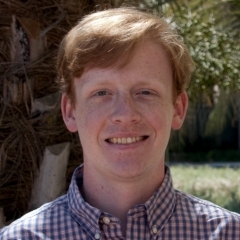
Date:
Location:
Speaker:
Title: "Flow-concentration coupling in entangled polymeric liquids"
Abstract: Flow-based polymer processing is ubiquitous in the formation of soft materials for applications ranging from healthcare to packaging. Polymer processing strategies have historically been determined empirically, where the maximum flow rate is often established by the onset of visual distortions from uniform flow. Such an approach prohibits predictive flow calculations for arbitrary flow environments and polymeric formulations. Theoretical advances over the past several decades have enabled molecularly informed rheological modeling of entangled polymer liquids; however, most models assume that the fluid composition remains uniform during flow. Several exceptions to this assumption are known for polymer solutions such as shear-enhanced concentration fluctuations and polymer migration across curved streamlines, but these effects are typically not accounted for in models due to the belief that these compositional heterogeneities either occur on a small scale, with an insignificant effect on the bulk flow behavior, or on diffusive timescales, which are much longer than typical processing flows. This belief has been challenged by a recently developed two-fluid theory for entangled polymers, which, under certain conditions, predicts that uniform flow is unstable due to a shear-induced demixing instability that results in shear banding (i.e., two or more regions of distinct shear rates across the fluid under a shear flow); however, there is a lack of experimental measurements to directly compare with this theory.
To fill this gap, this dissertation experimentally explores the coupling of shear-induced compositional changes to bulk flow behavior in entangled polymer liquids. To do this, a combination of novel rheo-optical techniques are developed and used to quantify both fluid velocity and concentration fields. Qualitatively different results are observed depending on the number of entanglements and osmotic susceptibility of the polymer solutions. For entangled polystyrene in dioctyl phthalate, spatial variations of shear-enhanced concentration fluctuations in startup shear are coupled to changes in the bulk flow. In particular, the presence of mesoscopic concentration heterogeneities coincides with a local effective viscosity increase of the fluid. Conversely, entangled polybutadiene in dioctyl phthalate exhibits macroscopic heterogeneities in concentration that coincide with shear banded velocity profiles, consistent with a two-fluid model that couples the flow to polymer concentration. The effect of polydispersity on the flow behavior of entangled polymer liquids was investigated by using chemically homologous, bidisperse polymer blends. Interestingly, differences in the flow behavior were observed for blends of equivalent numbers of entanglements, but different blend compositions. Lastly, the two-fluid model for entangled polymer solutions is used to investigate nonuniform flows that arise from shear-induced demixing in complex flow protocols (i.e., large amplitude oscillatory shear (LAOS)).
The results of this dissertation underscore the possibility for non-local concentration changes in flows of entangled polymeric liquids, and reveal a wide range of flow phenomena that result when it is operative. More generally, the concept of flow-concentration coupling is likely applicable to many other complex fluids and should be accounted for in future models to accurately describe their rheology.
Committee co-chairs: Matthew E. Helgeson and L. Gary Leal
Committee members: Glenn H. Fredrickson, Christopher M. Bates, and Omar A. Saleh



